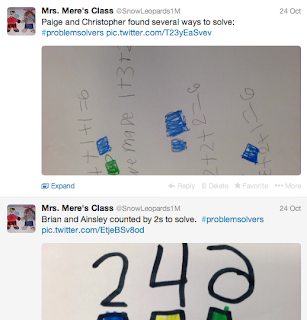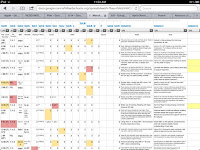"Somewhere we must come to see that human progress never rolls in on the wheels of inevitability. It comes through the tireless efforts and persistent work of dedicated individuals..." Martin Luther King at Oberlin College Commencement via the King Center
It seems quite common these days for people to speak out against public education. Politicians, business owners, and even some educators vocally demand change. Tighter accountability, common standards across the United States, testing mandates, and greater government control are constantly changing the landscape of the work we do. In all of the noise it is easy to lose sight of the real work we do.
Taking the time to attend the NCTE conference each year reminds me of the significance of the work we do in pubic education daily and helps me to stay focused on what matters most - children. This year's conferences was titled
(Re)Inventing the Future of English. As I've taken time to reflect on the time in Boston with so many educators I respect and admire, I took some time to try to weave the numerous thought provoking snippets into a story:
To Me (Re)Inventing the Future of English Means:
Collaborate beyond our classrooms: Teaching no longer is about what happens within our walls, but instead about how we collaborate and learn with others beyond our classrooms and around the world. This year I lived this as our six session presenters from a variety of locations worked across Google Hangouts, Google docs, and Twitter to plan and collaborate for this event. I was so excited to finally meet
Susan Dee and
Mary Bellavance as we joined
Karen Terlecky,
Deb Frazier, and
Katie Keier to share round table discussions:
Kidwatching in a Digital World.
Get connected: The future of English requires that we connect with others to learn and grow in literacy. At NCTE I was fortunate to meet many of the educators, authors, and literacy leaders who inspire me to learn and grow. The Choice Literacy dinner, #nerdybookclub gathering, Stenhouse gathering, as well as moving from session to session gave me time to chat with countless colleagues I learn from each day. We are fortunate to be able to bring authors right into our classroom, to learn alongside them at conferences, and to share their work with our students. We are able to connect as educators to improve our practice, advocate for change, and push our profession to grow and change. We can now connect our classrooms with other classrooms around the world. The greatest highlight of NCTE for me was meeting and talking with educators I learn from across the year. The significance of these connections is apparent in viewing the hashtag
#ncte13.
Dig for meaning: Stephanie Harvey, in a Doubling Down on Strategic Reading and Thinking with
Anne Goudvis,
Kristin Ziemke and
Katie Muhtaris, reminded us, "We teach kids to think so they can acquire and use knowledge." She added, "Complex text demands the reader's recognition and thoughtful consideration of many of facets of an idea, issue or problem." Students now have opportunities to use a variety of resources to learn more about their world.
Jo Ellen McCarthy talked about providing students with an invitation to notice, resources to discover, and a notebook to use as a place to capture their thinking (
Inquiry Notebooks with Marissa Moss and Erica Pecorale)
Allow time and choice for students to develop their reading/writing lives: From the start of the conference when
Jarrett Krosoczka, children's author, shared his beginning days as a reader/writer, speakers continually talked about the importance of finding time for students to develop their lives in literacy.
Be a reader and writer: Some things remain consistent in the future of English. One is that we, as educators, build our own reading and writing lives to more effectively help young learners in their journey.
Provide opportunities to compose in different ways using a variety of tools: In (Re)Imagining Literacy Workshop in a Digital Age
Bill Bass asked, "What does it mean to be literate in a time when things change constantly - when tools change constantly?" He,
Franki Sibberson, and
Ann Marie Corgill reminded us that the ways we read, learn, collaborate, and share are constantly changing. As teachers of English, we have to keep up with these changes and provide these opportunities for our young learners.
Audience and purpose matter: In the above mentioned session, Franki Sibberson reminded us that these new possibilities "invite intentionality."
Utilize new ways to capture the journeys of learners: New tools such as Evernote, EduCreations, Google docs, and VoiceThread allow us to (re)vision the way we collect the journeys of the learners in our classroom. (See our
Kidwatching in a Digital World Smore for links.)
Together we build forward: In the tweets shared by attendees throughout NCTE 2013, educators celebrated the work of Donald Graves and shared the ways Lucy Calkins, Nancy Atwell and other educators have changed the work we do in our workshops. As I synthesized these tweets I realized that "(re)-inventing the future" might also mean building up from the strong foundation built by the thoughtful work of other literacy educators.
Put children first: As I listened to sessions sharing ways students now own the learning in our classrooms I wondered:
"What does it mean for us in the field of education as kids lead the learning in our classrooms? How does it change our role as educators?" Ann Marie Corgill (in Re-Imagining Literacy Workshop) reminded us, "Small voices need to be heard." As educators we also have a responsibility to advocate for strong policy and practice.
"The function of education is to teach one to think intensively and to think critically. Intelligence plus character - that is the goal of true education." Martin Luther King, Jr.
We need public education to strengthen our society and nurture young literacy learners. Yes, schools should be places where students continue to grow. As educators we can utilize opportunities to amplify the voices of our students and speak up for change. As I listened in sessions I realized the changes are being made every day by the "persistent work of [the] dedicated individuals" who walk into their classrooms every day to make a difference. I'm just thankful they are willing to share all they do so I can also make changes that matter. Let's raise our words and (re)invent the future of English together.
.





























